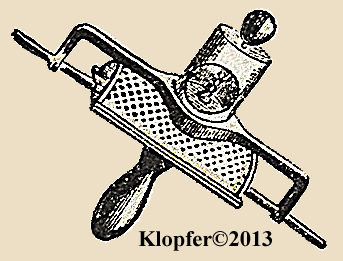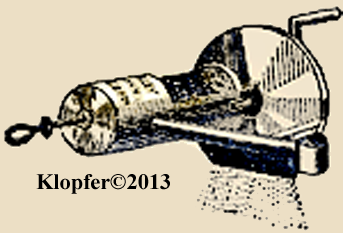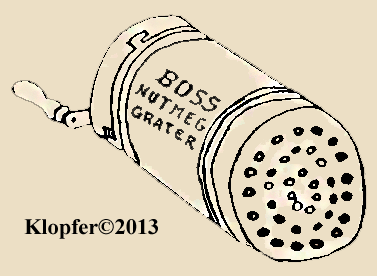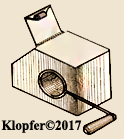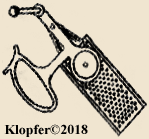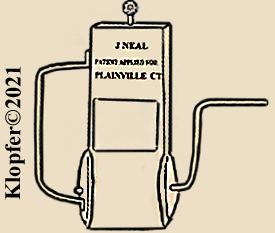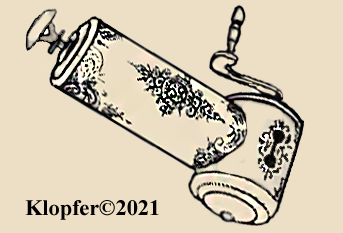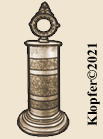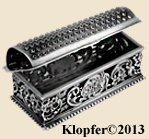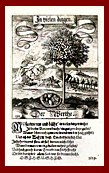 Click Me!
Click Me!
NutmegGraters.Com

- Home
- Featured Stories
- Picture Gallery
- Info.Wanted :
- Spurious Marks
- Trading Post
- Contact Our Site
- Wanted To Buy
[WELCOME: My articles published on NutmegGraters.Com and commercially (elsewhere) required many years of primary research, personal expense, travel and much effort to publish. This is provided for your enjoyment, it is required that if quoting my copyrighted text material, directly provide professionally appropriate references to me. Images are unavailable for copy. Thank you J. Klopfer.]
_______________________________________________________________________________________________________________________________________________________
The Common Sense Nutmeg Grater by Albert L. Platt
Midwestern American ingenuity: Albert L. Platt (1845/6~aft 1930) was born in Bloomington, Illinois. Among his many accomplishments, Albert was an inventor who obtained seven U.S. Patents, and at least one Canadian Patent for his innovations. Three of these patents pertain to "Improvements" with his nutmeg grater; a product developed across three different cities in two states, with locations indicated by red dots on map (Fig A): 1. Bloomington, IL, 2. Bowling Green, MO, & 3. Clinton, IL. Platt's "Common Sense" nutmeg grater remained in production for more than 20 years.
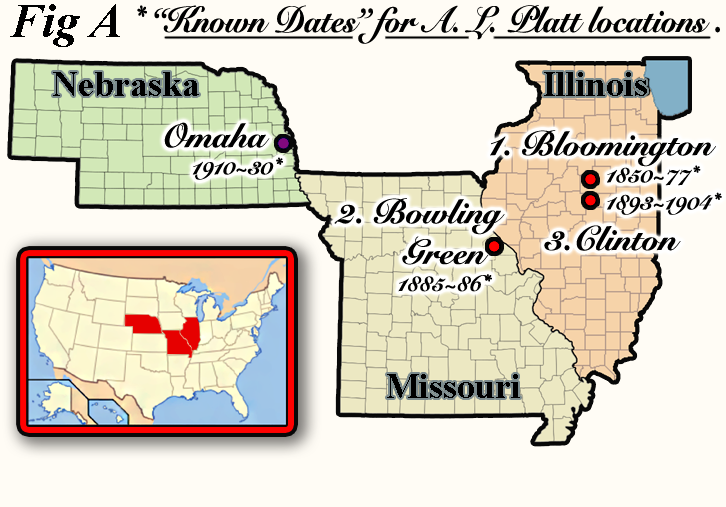 PLATT's "IMPROVEMENT IN NUTMEG-GRATERS" PATENT ~
PLATT's "IMPROVEMENT IN NUTMEG-GRATERS" PATENT ~
SEE (Fig B1.): The BLOOMINGTON Models:
[the first of three patents : patented April 22, 1873, № 138191.]
During the first quarter of the nineteenth century, the Mid-Western United States was still a wild, unbroken prairie that would rapidly develop into bustling towns and cities. On July 4, 1831, the empty plains area planned to become Bloomington, Illinois was first auctioned in lots, and by 1834 there were 180 residents, soon growing in 1837 to 450. Obtaining a population of 1611 inhabitants in 1850, Bloomington was incorporated as a city. With a railroad in full operation in 1853, Bloomington was booming with the high energy of builders, speculators and entrepreneurs.
Among these earliest prairie settlers to arrive, Ephraim Platt (1804~ ) settled in Bloomington Township in the Spring of 1833 where on March 8, 1837, he married Sarah Woodson (abt 1805~1879). First working as a shoe maker and later, as a carpenter, Ephraim Platt lived in Bloomington throughout the remainder of his life. He regularly held elected city positions: Street Commissioner (1853-55), City Marshal (1856/57), and Constable (1870's). He is last listed in the 1891 Bloomington City Directory, yet no death record was located.
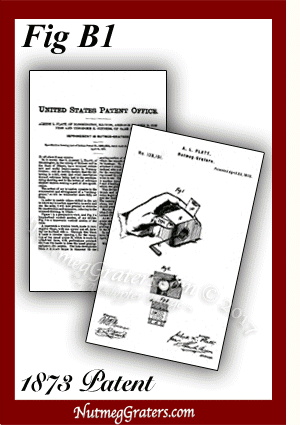 Each being widowed, this was the second marriage for both Ephraim and Sarah. They had five children together [Margarett, Charles, Albert L., Maria and George], plus Ephraim's three sons from his first marriage [Calvin, William & John] and Sarah's daughter [Henrietta Woodson] from her first marriage.
Each being widowed, this was the second marriage for both Ephraim and Sarah. They had five children together [Margarett, Charles, Albert L., Maria and George], plus Ephraim's three sons from his first marriage [Calvin, William & John] and Sarah's daughter [Henrietta Woodson] from her first marriage.  The focus of this "nutmeg grater history" centers upon their third child Albert L. Platt. [NOTE: NutmegGraters.Com seeks to located any image for Albert L. Platt, his family or his businesses. We would love to hear from anyone wishing to share any of these materials. Thanks you!]
The focus of this "nutmeg grater history" centers upon their third child Albert L. Platt. [NOTE: NutmegGraters.Com seeks to located any image for Albert L. Platt, his family or his businesses. We would love to hear from anyone wishing to share any of these materials. Thanks you!]
Bloomington was a small, rural city with many ingenious and inventive citizens who obtained more than 25 U.S. Patents between 1855 to 1873. Among them in 1873, Albert L. Platt secured his third U.S. Patent № 138191, the first of his three patents for a simple design of a nutmeg grater (Fig B1), and the patent listed "Assignors John D. Conners and Theodore K. Conners". Among patents of this period, most often an "Assignor" was an investor willing to manufacturer an invention, as was the case here. In all likelihood, all three work together in that Albert L. Platt is listed at this time as a "carpenter", while John Denny Conner (1820~1884) and Thomas K. Conner (1841~1904) were both "tinners". The original patent design (Figs B1 & B2) consists of a very basic "wooden block, made in rectangular shape, with one corner cut off" and a hinged tin lid to cover the opening where a nutmeg is inserted. Using one's finger, the nutmeg is pressed against "the grating surface of the cylinder"... with its "attached crank". Two later alteration to the patent's design (both bearing the patent date "PAT'D APR 22, 73") were created: the 1st variation simplified the shape of the tin lid into an arched cover (Fig B4); the 2nd variation altered the shape of the wooden block into a simple parallelogram (Fig B5). The full duration and long term location(s) of manufacture are not clearly established, but in 1982, NutmegGraters.Com identified and visited the primary location where this nutmeg grater was known to be manufacture until 1876 (detailed below).
Prior to this invention, both John and Albert had obtained other patents. John Conner invented a "washing machine": patented Nov. 2, 1869, № 96397 and Albert developed two "Ice Cream Freezers"; patented Aug. 15, 1871, № 118149 and Nov.19, 1872, № 133251. These too were the products made by these innovators.
As a boy born in Delaware, about 1830 John D. Conner's family first relocated to Ohio before moving on to Fulton, Illinois. John's younger brother Theodore was born in Fulton in 1841. Throughout their lives both brothers worked as tinsmiths. Although their primary resided would remain Fulton (Bryant), Illinois, several times John ventured the 80 miles to Bloomington, where he would unsuccessfully attempt to establish a permanent livelihood. John was in Bloomington in 1846, when he painted a portrait of his three month old daughter and only child "Josephine Conner" [Portrait shown by Barbara Wells Sarudy and sold by Antiques Associates At West Townsend Inc. In 1870~72, he worked as a "tinner" for G. H. Read & Bro. [Gordon H, & Charles H] at their "house furnishing goods, stove, tinware, cutlery and woodenware store" at 205 N. Main Street before opening his own business. From 1873 to 1875, J. D. Conner & Bro. retailed "Stoves and Tinware" at 516 North Main Street, after which time the business name became Conner & Faloon (mnfrs, ice cream freezers). It is apparent that these early versions of Platt's Common Sense Nutmeg Grater and Platt's patented "ice cream freezers" of 1871 & 1872 were produced at this location. These endeavours were short lived, and in 1876/7 John was listed only as a "tinner". In the years that followed, neither John nor his business interests are listed in the Bloomington City Directory. Also, Albert Platt disappears from the Bloomington City Directory after 1876/7, briefly reappearing seven years later as a "pattern maker" and "carpenter" in the 1884/5 to 1886/7 directories. Interestingly, this re-emergence overlaps the period when his second "Nutmeg Grater" patent № 334279 was obtained.
Combined in (Fig C) are the Bloomington city map of 1874 and three dimensional building images from the Bloomington Birds Eye View Maps of 1863 and of 1873; Image #2 features the building where J. D. Conner & Bro. was located at its northern most end. Photographed in 1982, Image #4 shows the southern most end of this same, then partially vacant building [Notice that the corner unit reflects the original architecture seen in Image #2, with neighboring store-fronts in the building being modernized]. Image #1 shows the probable home of Ephraim Platt where Albert lived with his parents until 1871/2 and Image #3 shows the probable home for Albert in 1873 where he moved when his products were under manufacture.

PLATT'S "NUTMEG-GRATER" PATENT 1886 ~
SEE (Fig D1): The Bowling Green, Missouri Model:
[the second of three patents : patented January 12, 1886 (filed September 29, 1885) № 334279.]
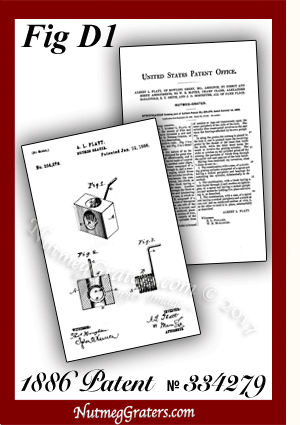 The second in the series of three nutmeg grater patents, Albert L. Platt obtained U.S. Patent № 334279 on January 12, 1886 (Figs D1, D2 & D3). Being originally filed on September 29,1885, the time-line for his "new and useful Improvement in Nutmeg•Graters" patent creates a puzzle. Although the patent states his residency as "Albert L. Platt, of Bowling Green, MO", extensive research found no evidence to verify that Albert ever lived there. Adding to this puzzle, two consecutive Bloomington City Directories, dated 1884 & 1886, list his residency there, with Albert as a "pattern maker" in 1884 and a "carpenter" in 1886.
The second in the series of three nutmeg grater patents, Albert L. Platt obtained U.S. Patent № 334279 on January 12, 1886 (Figs D1, D2 & D3). Being originally filed on September 29,1885, the time-line for his "new and useful Improvement in Nutmeg•Graters" patent creates a puzzle. Although the patent states his residency as "Albert L. Platt, of Bowling Green, MO", extensive research found no evidence to verify that Albert ever lived there. Adding to this puzzle, two consecutive Bloomington City Directories, dated 1884 & 1886, list his residency there, with Albert as a "pattern maker" in 1884 and a "carpenter" in 1886.
The small city of Bloomington, Illinois is approximately 160 miles from the even smaller city of Bowling Green, Missouri. The population of Bowling Green was 1067 in 1880, growing only to 1564 by 1890; so, why would Albert L. Platt be drawn to such a small place? One possible explanation is that extended Elliot family members resided in this area. In 1833, on the eastern side of the Mississippi River, Rev. Jeremiah Evarts Platt had settled 2½ generations earlier in Adams County, Illinois and many Platt descendants remained in this vicinity. Although this is plausible, beyond what is stated on the actual patent, there is no other direct evidence to support Albert living in Bowling Green. What is documented is that Albert was constantly on the go, leaving behind a patchwork quilt of short lived, and regularly changing addresses. Albert's residence in Missouri would have been very brief, if at all.
It is doubtful that the version of the nutmeg grater pictured on the actual patent (Fig D1 & D2) was ever actually manufactured as shown. Among numerous and significant private and public collections (to include antique auctions and show sales), this exact design remains completely unknown. Based on simple inspection, one quickly surmises that the patent has a design flaw [encircled in red (Fig D3) and patent described: "a spiral coil … (b), whose end is bent around outside of the block and prevents the spiral cylinder from slipping out of its case"]. This small "bent" tip design is very flimsy and with certainty, it would fail to retain the "notched coil cylinder" in place during standard and continued use.
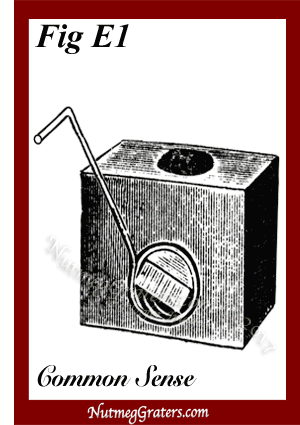 Developing a more practical redesign, Albert reconstructed his nutmeg grater (Fig E1, E2, & E3). The "spiral coil having a nicked periphery and a crank at one end" was secured using a small wooden block insert within the coils (Fig E1, E3, & E4) and fastening this unit to the back wall of the main "wooden block" with a screw (Fig E2). The coil assembly turned via an simple axel pivot. Notice within the photographs (Fig E2 & E3), there is the faded, illegible remanent of a paper label on one end. What appears as an advertisement (a hand-bill or detached page) provides us with the trade name "Common Sense Nutmeg Grater" (Fig E4). It remains unknown where and for how long this variation of the nutmeg grater was manufactured, but 6 years after its introduction, Albert would obtain his third patent for "useful Improvements in Nutmeg-Graters".
Developing a more practical redesign, Albert reconstructed his nutmeg grater (Fig E1, E2, & E3). The "spiral coil having a nicked periphery and a crank at one end" was secured using a small wooden block insert within the coils (Fig E1, E3, & E4) and fastening this unit to the back wall of the main "wooden block" with a screw (Fig E2). The coil assembly turned via an simple axel pivot. Notice within the photographs (Fig E2 & E3), there is the faded, illegible remanent of a paper label on one end. What appears as an advertisement (a hand-bill or detached page) provides us with the trade name "Common Sense Nutmeg Grater" (Fig E4). It remains unknown where and for how long this variation of the nutmeg grater was manufactured, but 6 years after its introduction, Albert would obtain his third patent for "useful Improvements in Nutmeg-Graters".
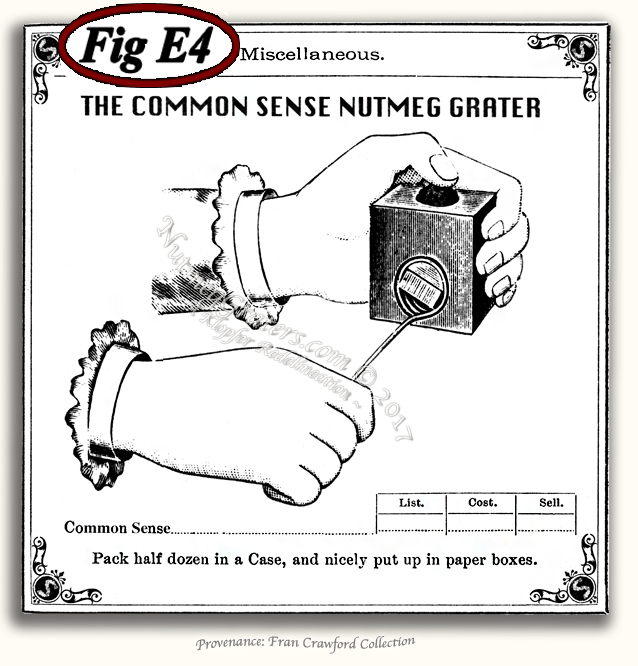 The 1886 Patent designated "W. B. McPike, Champ Clark, Alexander McDannold, E. T. Smith and J. D. Hostetter" as "Assignor, By Direct And Mesne Assignments". Unlike the initial nutmeg grater patent which assigned shared apportionment with the Connor brothers, the conditions for assignors in this second nutmeg grater patent uses terminology infrequently found within nineteenth century U.S. patents. The terms "Assignor, By Direct And Mesne Assignments" indicate the prior vested financial agreements of the earlier patent and set specific limitations in rights (which would have been stipulated using additional separate contracts). Primarily, these 5 "assignors" shared limited "investment interests" with the manufacture of this new model of the Platt nutmeg grater.
The 1886 Patent designated "W. B. McPike, Champ Clark, Alexander McDannold, E. T. Smith and J. D. Hostetter" as "Assignor, By Direct And Mesne Assignments". Unlike the initial nutmeg grater patent which assigned shared apportionment with the Connor brothers, the conditions for assignors in this second nutmeg grater patent uses terminology infrequently found within nineteenth century U.S. patents. The terms "Assignor, By Direct And Mesne Assignments" indicate the prior vested financial agreements of the earlier patent and set specific limitations in rights (which would have been stipulated using additional separate contracts). Primarily, these 5 "assignors" shared limited "investment interests" with the manufacture of this new model of the Platt nutmeg grater.
All five of the venture capitalist listed as assignors were interconnected by their professional and/or spiritual affiliations. They were citizens having significant political, religious, patrimonial heritage and social standing, both in Bowling Green and in the state of Missouri (a synopsis of each man is detailed below).
Snapshots:
About Bowling Green, Missouri / Plus Its Esteemed Entrepreneurs & Investors In Platt's Common Sense Nutmeg Grater:
Bowling Green, Missouri ~
The Louisiana Purchase of 1803 expanded the United States beyond the Mississippi River. Along the river in Missouri Territory, Pike County was organized in 1818. The next year, Bowling Green (Fig A 2.) was settled, designated the county capital in 1824. During the 1860's Pike County was nicknamed "Little Dixie"; most of the residence being with Southern roots from Kentucky, Georgia, or Virginia. During the American Civil War, there were equal numbers of men who fought for the Confederacy, as fought for the Union. In 1886, the citizens of Bowling Green were hard working, industrious, conservative and virtuous. Religious values were dominant and alcoholic consumption was undesirable. Located along the Mississippi River, agriculture was king and the views along the river remain as beautiful now, as they were then.
Assignors ~
William B. McPike (1841~1923) was born in Missouri to Rachel J. (of Virginia) to Benjamin H. McPike (of Kentucky). In the fall of 1880, William relocated to Bowling Green where he engaged in the grain business, having several large grain elevators. William later, ventured into banking. In the 1870's and 1880's, William served as the "clerk" for the Salt River Association Baptist fellowship. In 1910, he patented a "Spinning~Wheel".
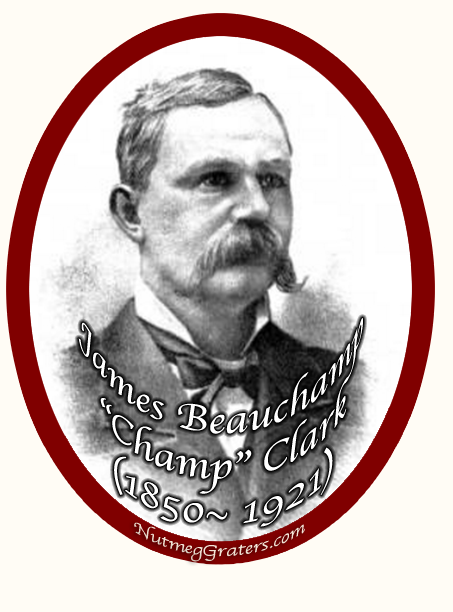 James Beauchamp "Champ" Clark (1850~1921) was born and raise on a farm in Kentucky to Aletha Jane & John Hampton Clark. "Champ" moved to Pike County, Missouri in 1875. He held a variety of positions (a high school principal, an attorney, and a newspaper editor), becoming city attorney for Louisiana, Missouri, then city attorney for Bowling Green and finally Pike County attorney. He moved to Bowling Green in 1880. His claim to fame was being elected to the U.S. Congress (1893~1895 & 1897~1921) where he served as Speaker of the United States House of Representatives (1911~1919). He unsuccessfully ran for President of the United States in 1912 and died during his last term in Congress. The Clark family home "Honey Shuck" was acquired at Bowling Green in 1898. Their house became a National Historic Landmark in 1976.
James Beauchamp "Champ" Clark (1850~1921) was born and raise on a farm in Kentucky to Aletha Jane & John Hampton Clark. "Champ" moved to Pike County, Missouri in 1875. He held a variety of positions (a high school principal, an attorney, and a newspaper editor), becoming city attorney for Louisiana, Missouri, then city attorney for Bowling Green and finally Pike County attorney. He moved to Bowling Green in 1880. His claim to fame was being elected to the U.S. Congress (1893~1895 & 1897~1921) where he served as Speaker of the United States House of Representatives (1911~1919). He unsuccessfully ran for President of the United States in 1912 and died during his last term in Congress. The Clark family home "Honey Shuck" was acquired at Bowling Green in 1898. Their house became a National Historic Landmark in 1976.
Alexander McDannold. Although Platt's patent includes an assigner named "Alexander McDannold", several Missourians from this period shared this same exact name. It seems likely that Alexander L. McDannold (1846~ ) of Calumet Township (adjacent to Bowling Green) is the individual named on the patent. Alexander was born and raised on a Calumet farm by Martha C. McDannold (of Virginia) and Judge Newton McDannold (of Kentucky). He was a member of the Salt River Association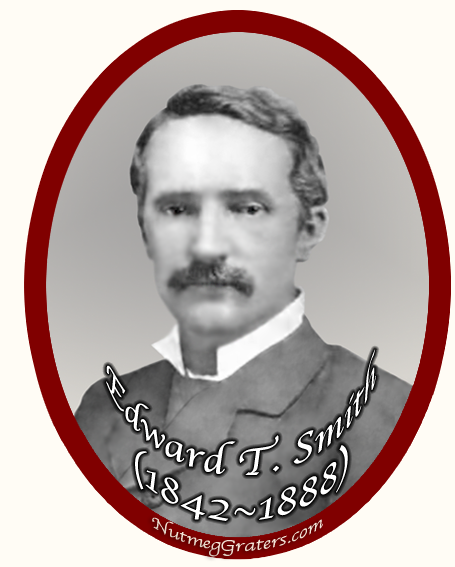 Baptist fellowship. Alexander worked as a stock broker, and in later years resided in nearby Pittsfield City, Illinois. Signatures by other "McDannold" individuals are found among E. T. Smith probate documents (see next), indicating that there was a close family connection.
Baptist fellowship. Alexander worked as a stock broker, and in later years resided in nearby Pittsfield City, Illinois. Signatures by other "McDannold" individuals are found among E. T. Smith probate documents (see next), indicating that there was a close family connection.
Edward Thomas Smith Esq. (1842~1888) was born in Missouri (probably) to Mary A. (Dingle) and James Frank Smith (of Kentucky). Appointed in 1870 to Secretary an the Democratic County Convention, he worked at the state level for that party. An attorney, he was Pike County Prosecuting State's Attorney in 1874 and again in 1880. He was a Confederate soldier. In 1877 to 1879, Edward contracted with the State of Missouri "For Carrying The Mails" between a number of local routes. Both he and his father were influential members of Salt River Association Baptist fellowship.
Jefferson Davis Hostetter (1861~1939) was born and raised on a farm in Frankford, Pike Co. MO to Louisa (Sutton) and Gabriel Hostetter (both born in Pike County, MO). "J. D." was an attorney admitted into the Missouri Bar in Bowling Green in 1884. He was reelected into the Missouri State Congress 1917 to 1923 and was appointed in 1935 as Presiding Judge with the St. Louis Court of Appeals where he served until his death.
PLATT'S "NUTMEG-GRATER" PATENT 1893 ~
SEE (Fig F1): The Clinton, Illinois Model:
[the third of three patents : patented October 3, 1893 (filed February 6, 1893) № 505886.]
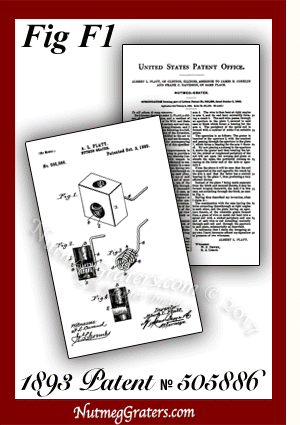 Filed on February 6, 1893; Albert L. Platt's third and final patent for "certain new and useful Improvements in Nutmeg-Graters" was granted on October 3, 1893 and designated U.S. Patent № 505886 (Fig F1). Being only 20 miles south from Bloomington, Albert now resided in Clinton, Illinois. So too did his two patent "Assignor(s) ... James H. Conklin and Frank C. Davidson". During the period between 1886 and 1897, Conklin and Davidson were business partners in a successful real-estate business and both served as financial backers for Albert's newly revised nutmeg grater invention.
Filed on February 6, 1893; Albert L. Platt's third and final patent for "certain new and useful Improvements in Nutmeg-Graters" was granted on October 3, 1893 and designated U.S. Patent № 505886 (Fig F1). Being only 20 miles south from Bloomington, Albert now resided in Clinton, Illinois. So too did his two patent "Assignor(s) ... James H. Conklin and Frank C. Davidson". During the period between 1886 and 1897, Conklin and Davidson were business partners in a successful real-estate business and both served as financial backers for Albert's newly revised nutmeg grater invention.
Albert's final design simplified his method to assemble his nutmeg grater; ~ with a "grater consisting of a piece of stiff wire bent into a spiral coil" and having "one end of which is bent inwardly and extended centrally through the coil to the opposite end" (Figs F2 & F3). The "wire passes through an aperture in the {tin} plate ... secured to {the back of the wooden} block" (Fig F4). With this final design, Albert Platt improved ease in production. Now, the tin/wire "grater assembly" was built as an independent unit which effortlessly was inserted into the wooden block and then affixed into place using 4 nails (Fig F4).
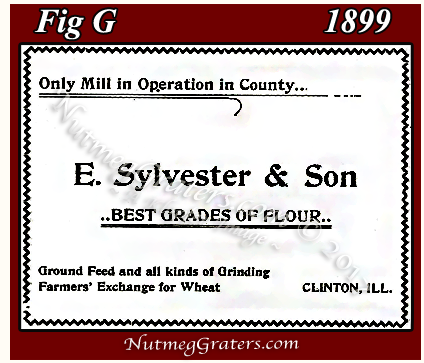 Clinton, Illinois inconsistently maintained any residential record prior to it's first Clinton City Directory in 1899, thus it is unknown when Albert first moved to Clinton. The 1899 directory points out that Albert was both an independent "inventor" and a "miller". Albert appears to be employed by E. Sylvester & Son ... the "Only Mill in Operation in County ..." (Fig G). Although James Conklin remains in his real-estate business his entire life, Frank Davidson became the Clinton "postmaster" in 1897. The 1899 Clinton City Directory announced "It is confidently expected that Clinton will soon be favored with a free mail delivery, necessitating the numbering of every house. In this issue, it has been possible to give only two-thirds of the house numbers." Under Davidson's supervision, Clinton's postal services were quickly expanded, and about 1900, Davidson engaged his friend Albert Platt as the mail carrier of "Route №. 1." Following the marriage of Albert's son Harry, Albert leaves Clinton in 1905, when it is assumed that the nutmeg grater went out of production.
Clinton, Illinois inconsistently maintained any residential record prior to it's first Clinton City Directory in 1899, thus it is unknown when Albert first moved to Clinton. The 1899 directory points out that Albert was both an independent "inventor" and a "miller". Albert appears to be employed by E. Sylvester & Son ... the "Only Mill in Operation in County ..." (Fig G). Although James Conklin remains in his real-estate business his entire life, Frank Davidson became the Clinton "postmaster" in 1897. The 1899 Clinton City Directory announced "It is confidently expected that Clinton will soon be favored with a free mail delivery, necessitating the numbering of every house. In this issue, it has been possible to give only two-thirds of the house numbers." Under Davidson's supervision, Clinton's postal services were quickly expanded, and about 1900, Davidson engaged his friend Albert Platt as the mail carrier of "Route №. 1." Following the marriage of Albert's son Harry, Albert leaves Clinton in 1905, when it is assumed that the nutmeg grater went out of production.
Snapshot: For Clinton, Illinois And For Patent № 505886 "Assignors":
Clinton, Illinois ~
Since its earliest settlers arrived in 1828, Clinton remains a small rural community know for its long and prosperous agricultural heritage, which continues on today. It is here where Abraham Lincoln first delivered his famous response to Stephen Douglas: "You can fool some of the people all of the time, and all of the people some of the time, but you can't fool all the people all of the time." Quaint, quite and serene; Clinton described itself as a community "where you are warmly welcomed as a visitor".
Assignors ~
James H. Conklin (1838~1909) was born in Muskingum County, Ohio to Bridget (McKernan; born in Ireland) and William Conklin (born in Washington County, Pennsylvania). As a traveling peddler in the 1860's, William sold Seth Thomas clocks from his wagon throughout rural districts of DeWitt, Piatt and other Illinois counties, eventually settling in Illinois with his wife and children. During the Civil War, James was a Union soldier assigned to Tennessee. Following his military service, James resettled to Clinton, Illinois. In 1870, James established a real estate, loan and insurance business where by 1886, he was joined in business by Frank C. Davidson (see next). The firm was renamed Conklin & Davidson Real-Estate. In 1886, and again in 1888, James was elected Alderman for the Second Ward of Clinton. He acquired a valuable land tract where he erected a palatial home on North Center Street. He retired from Clinton about 1901.
Frank C. Davidson (1853~1918) was born in Champaign County, Illinois to Elizabeth Jane (Sidner) and Thomas A. Davidson (both born in Rockbridge County, Virginia; both, as youths, relocating with family to Ohio). Frank was born and raised on a Champaign County farm. Becoming a railroad employee at age 17, Frank was trained as a telegraph operator, which later positioned him to work in banking; first in London, Ohio and then in Urbana, Illinois. In 1878, Frank settled in Clinton, Illinois, where he established a tile business (1878~ 1886) and later, a real-estate partnership (1886~1897). He was appointed Clinton's postmaster June 23, 1897, a position which he retained until his death in 1918.
Endnotes:
 After leaving Clinton, Illinois in 1905, it appears likely that Albert L. Platt moved to Louisville, Clay, Illinois, before resettling in Omaha, Nebraska. It was in Omaha that Albert's obtained his final U.S. Patent № 1517454 for a mechanical ring-toss game of skill on November 9, 1922. The U.S. Census of 1930 indicates Albert as an 84 year old widow, residing with his daughter Helen and son-in-law George W. Cole on Ida Street in Omaha. No later records were found.
After leaving Clinton, Illinois in 1905, it appears likely that Albert L. Platt moved to Louisville, Clay, Illinois, before resettling in Omaha, Nebraska. It was in Omaha that Albert's obtained his final U.S. Patent № 1517454 for a mechanical ring-toss game of skill on November 9, 1922. The U.S. Census of 1930 indicates Albert as an 84 year old widow, residing with his daughter Helen and son-in-law George W. Cole on Ida Street in Omaha. No later records were found.
During the American Civil War, Albert L. Platt was among the One Hundred-Day Men ~ "a volunteer force of 85,000 one hundred-day men, to relieve the veteran soldiers from guard duty at our forts, arsenals and elsewhere. Of this number, Illinois furnished thirteen regiments and two battalions." Albert enlisted for two cycles of military service, first in 1864 and then in 1865/6. Published on-line, Albert's "letter of July 21, 1864" to "Friend Molly", illustrates the conditions experience among Company B, 145th Illinois Infantry. Authored by Griff, the associated article "1864: Albert L. Platt To Molly" makes for interesting reading (on-line at the blog site Spared E Shared 7 ~ Saving American history One Letter at a Time.)
Albert L. Platt's line of nutmeg graters were produced for more than 20 years. Today, any one of the Commons Sense Nutmeg Graters by Albert L. Platt are considered as scare collectibles.
Help us find additional photographs of Albert L. Platt, his family, home or business. We would love to include these images with this research.
Is anyone wishing to share their images? Let us hear from you. Thanks you!
[KLOPFER article © May 2017]
